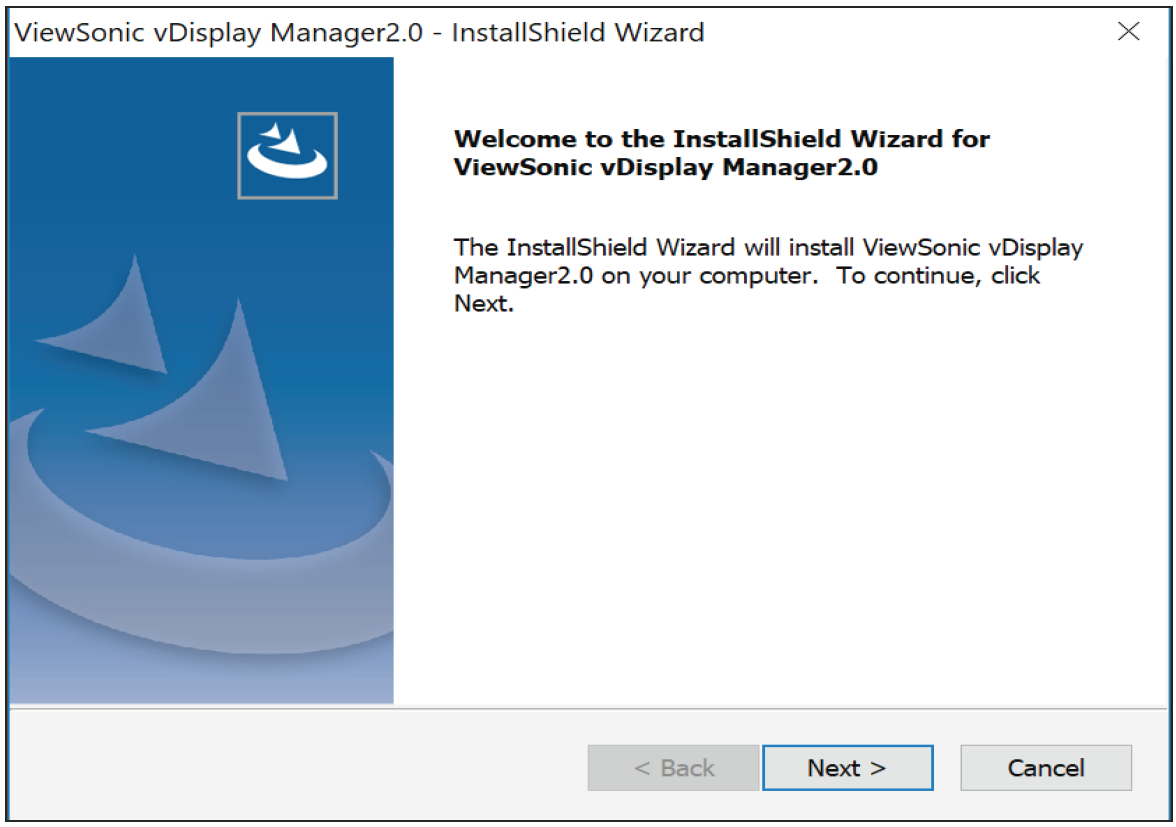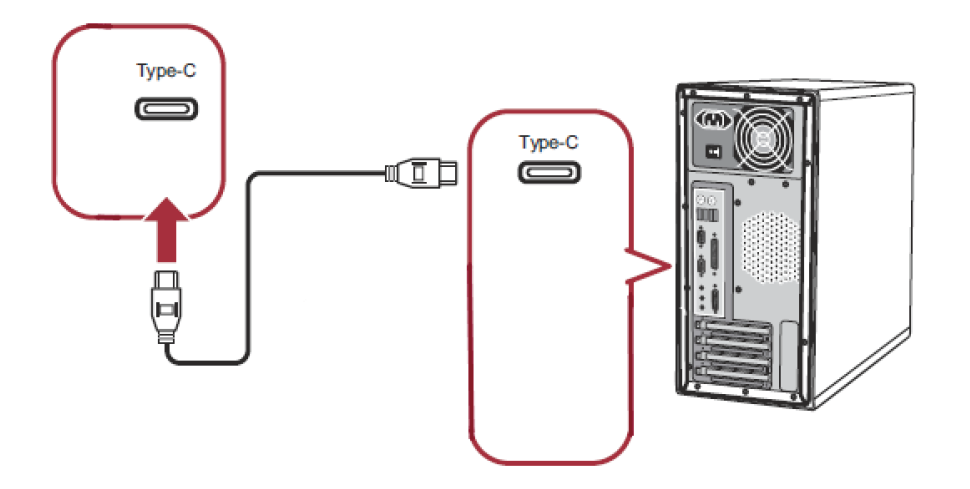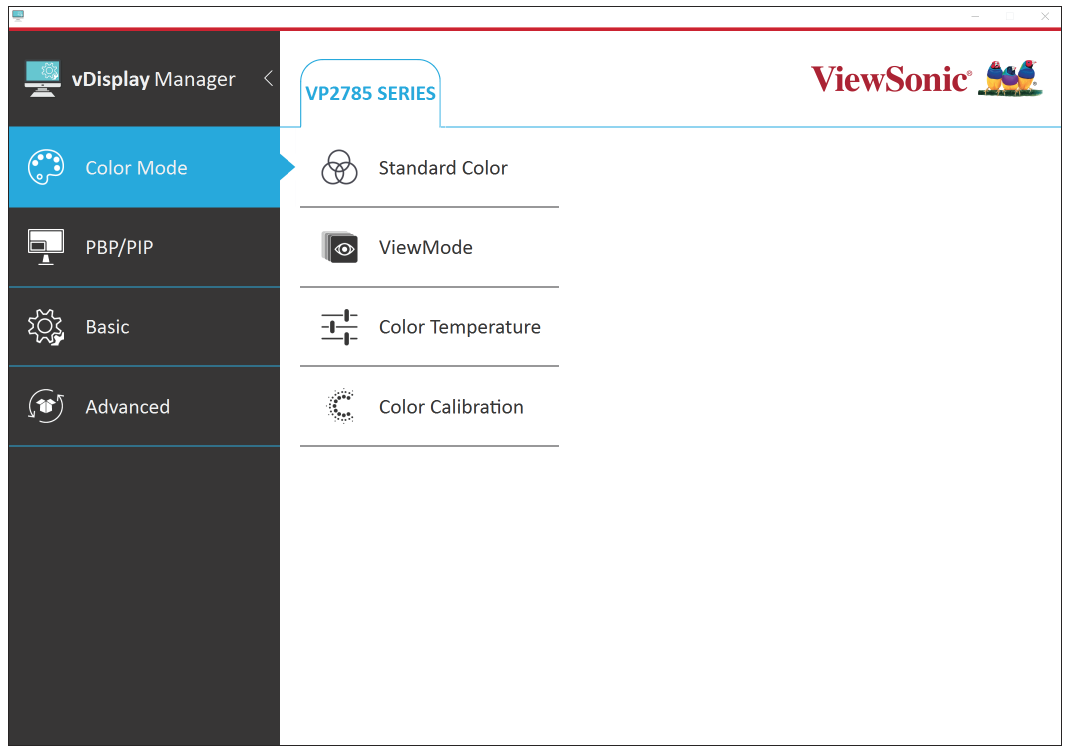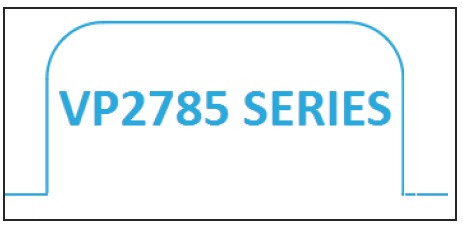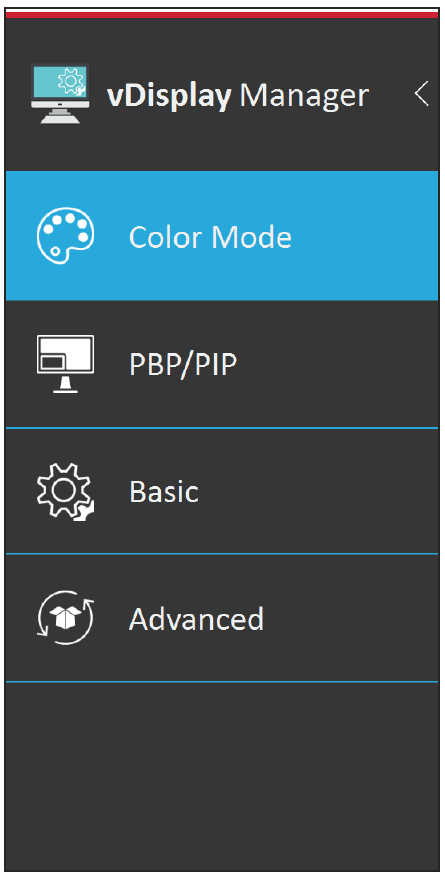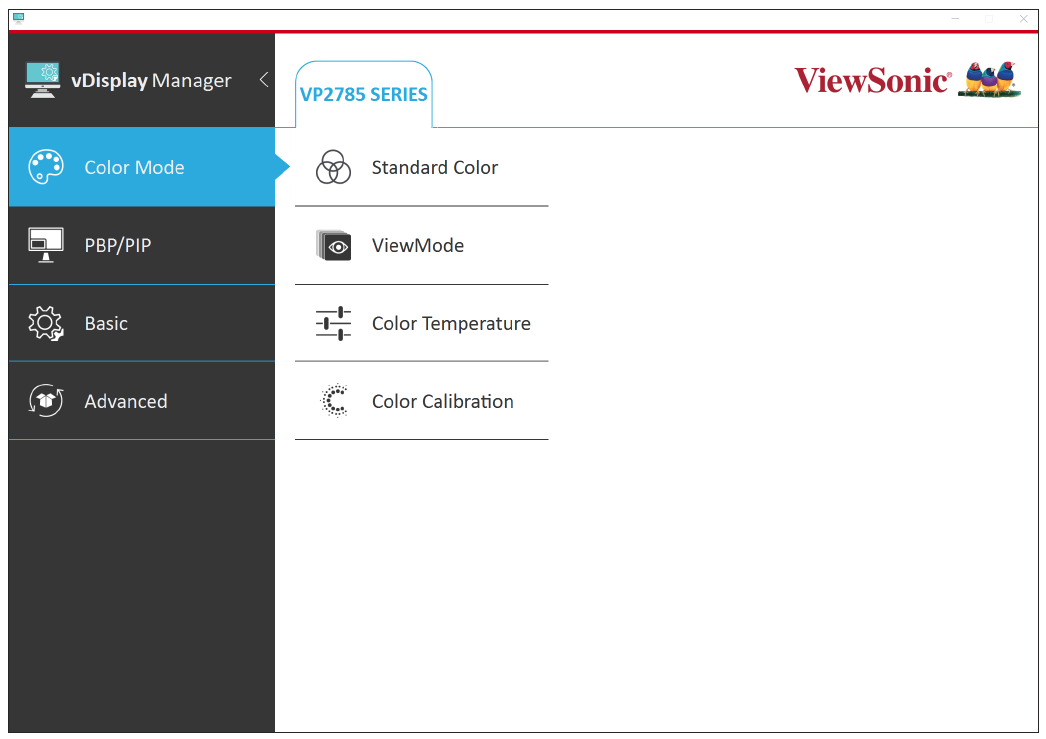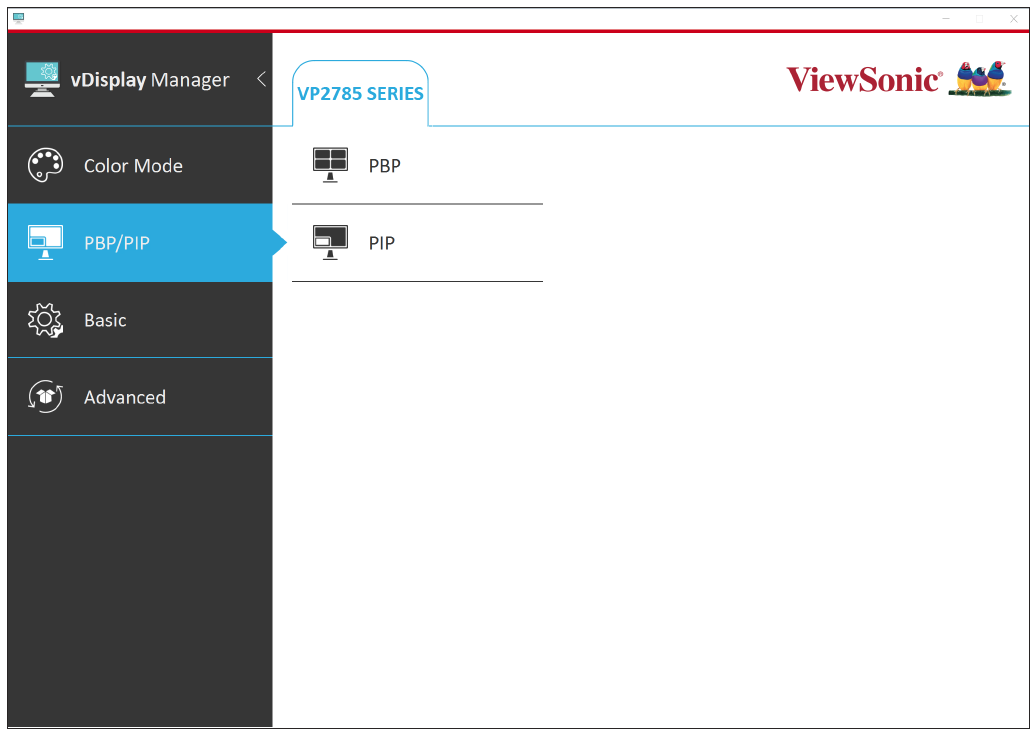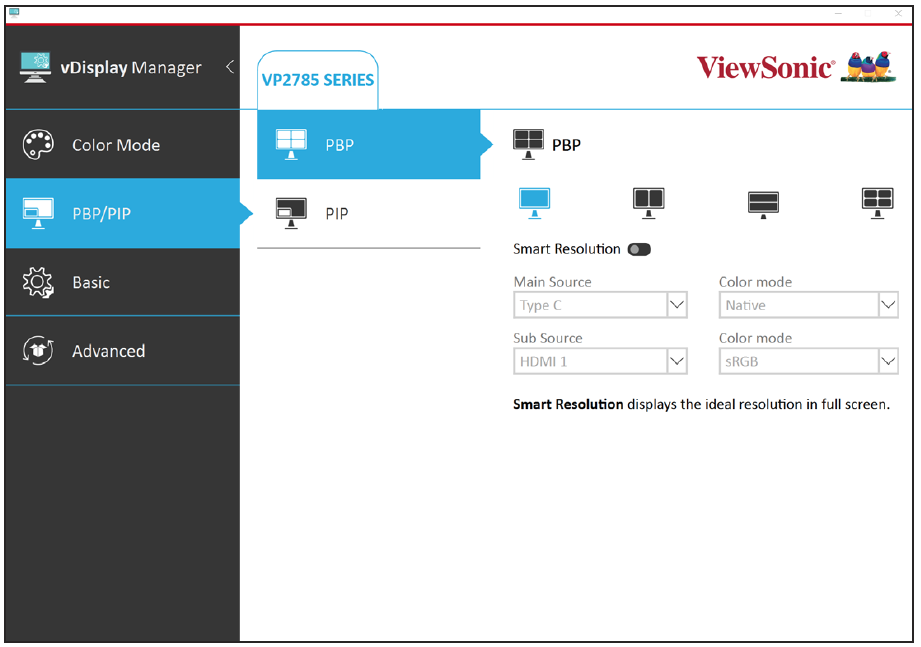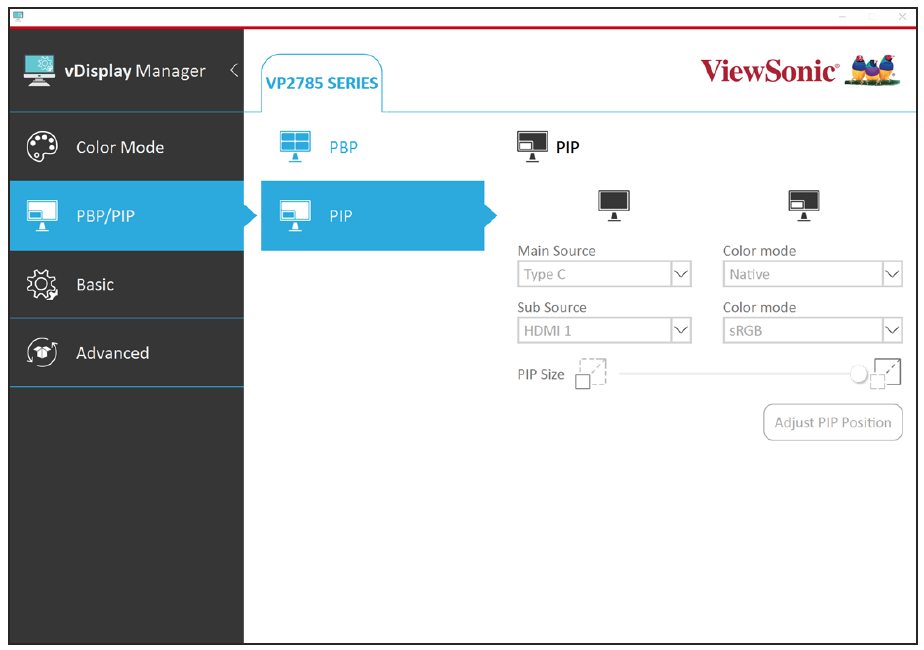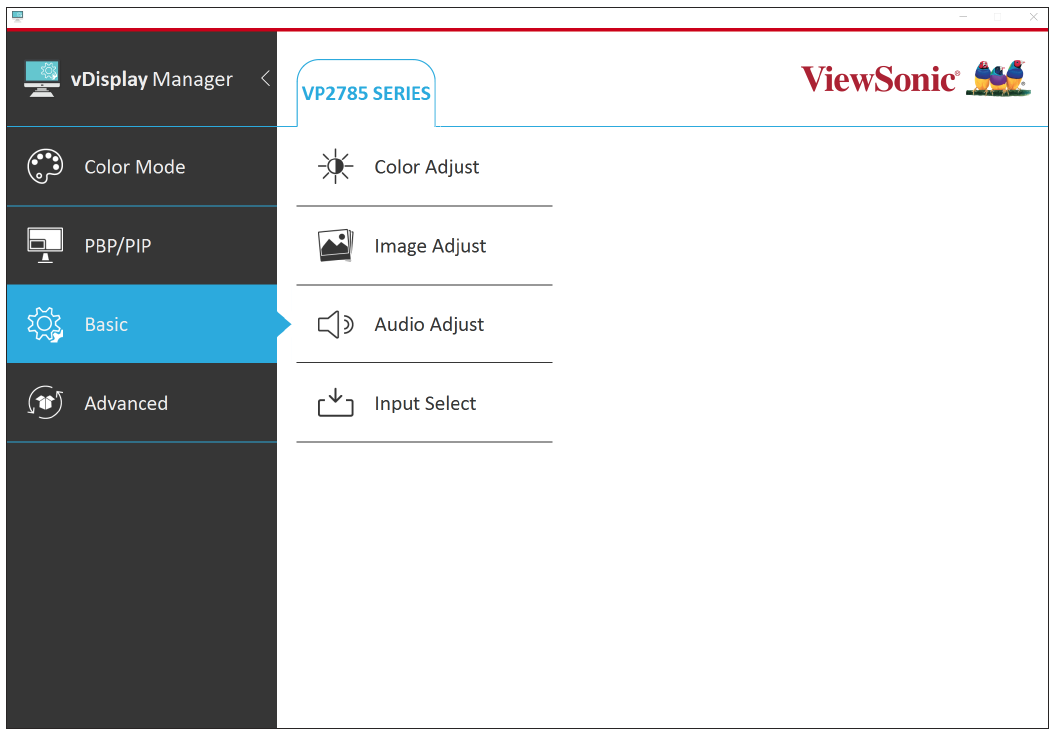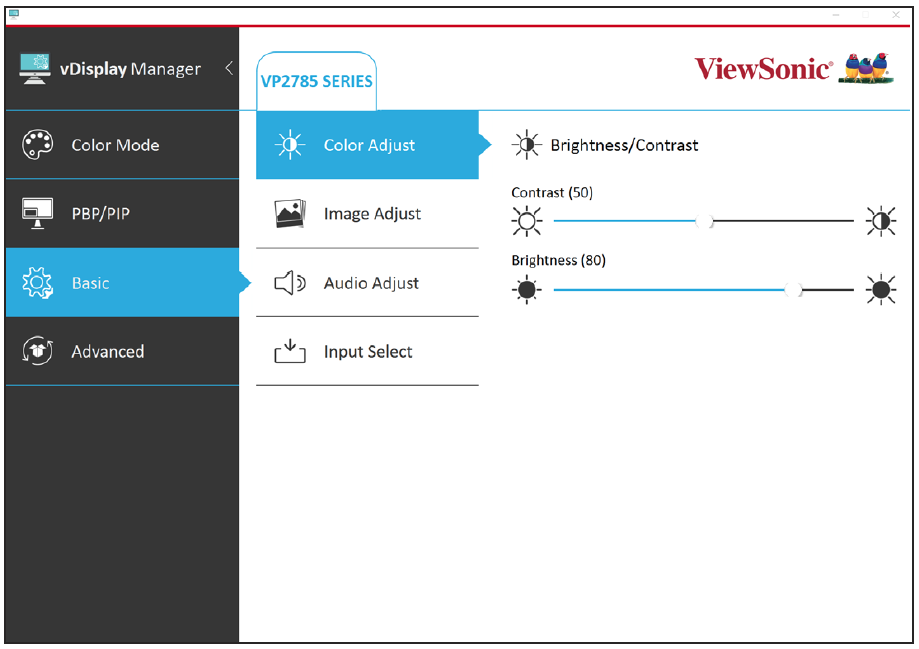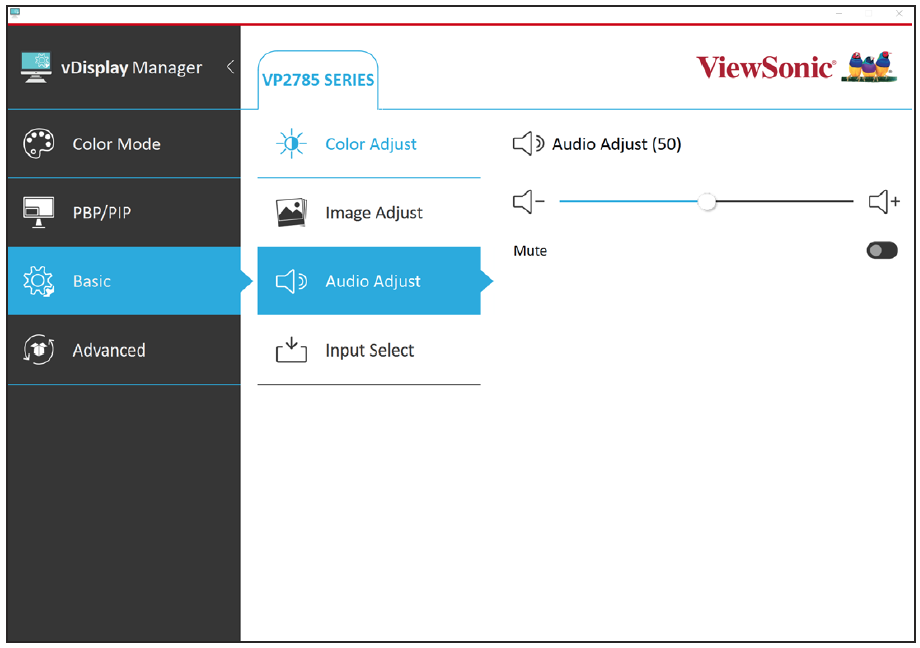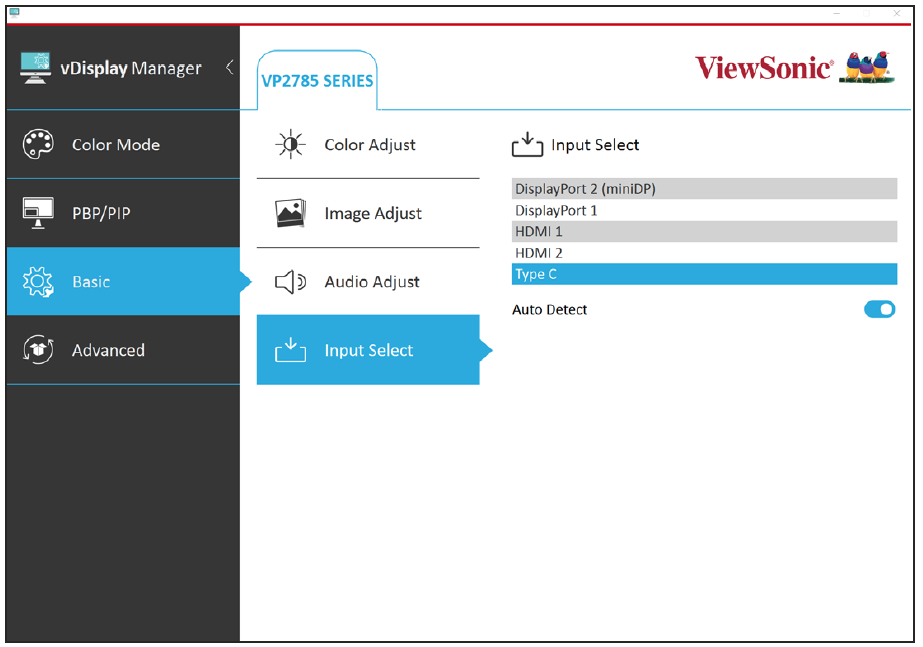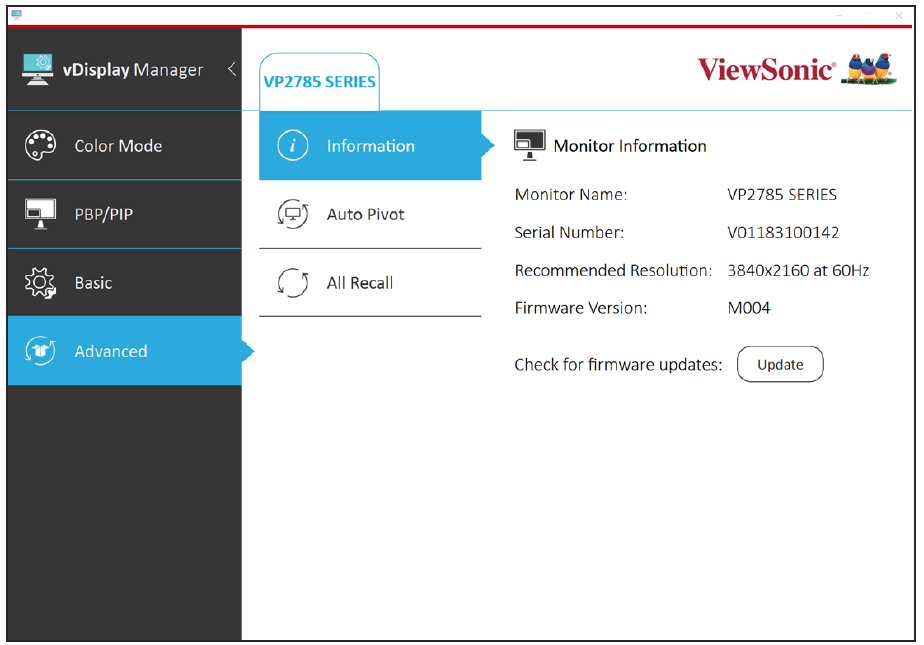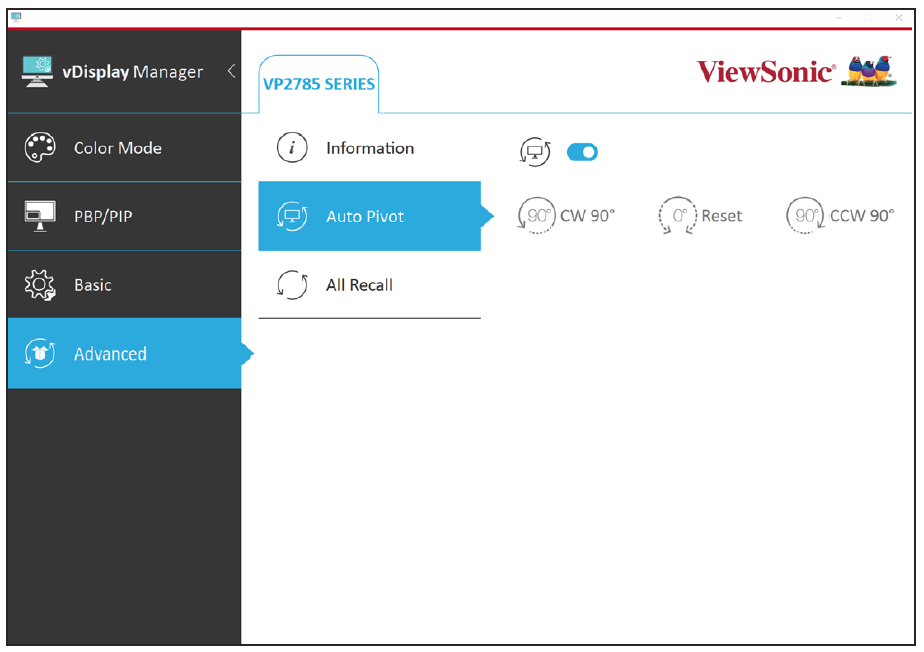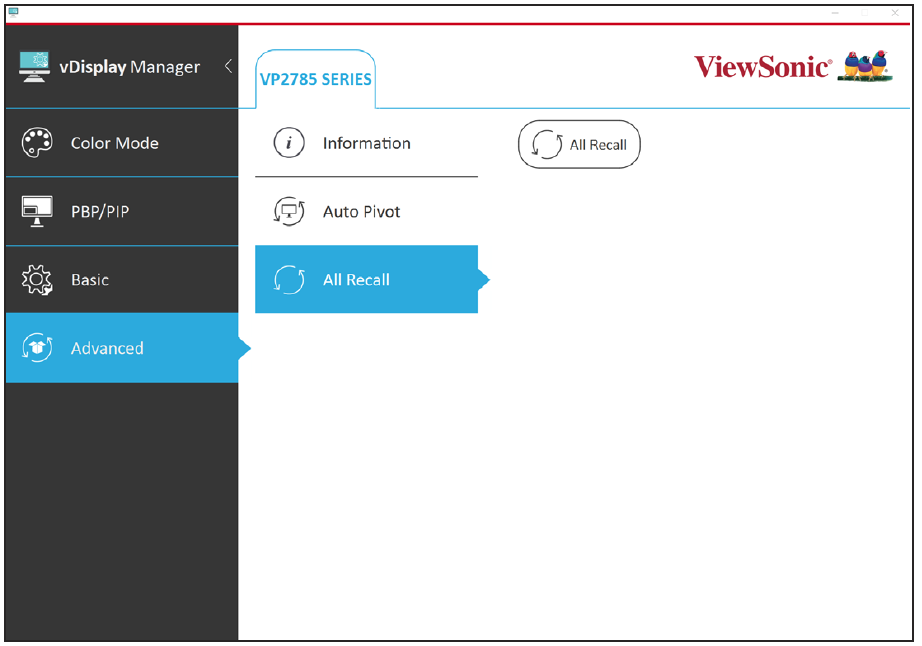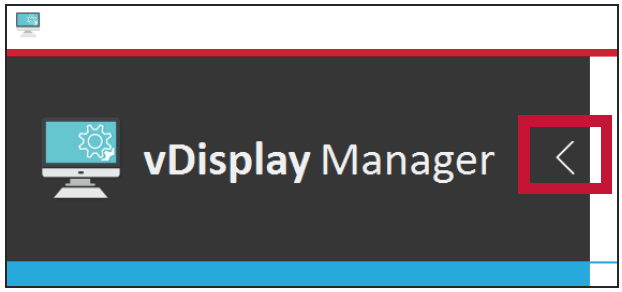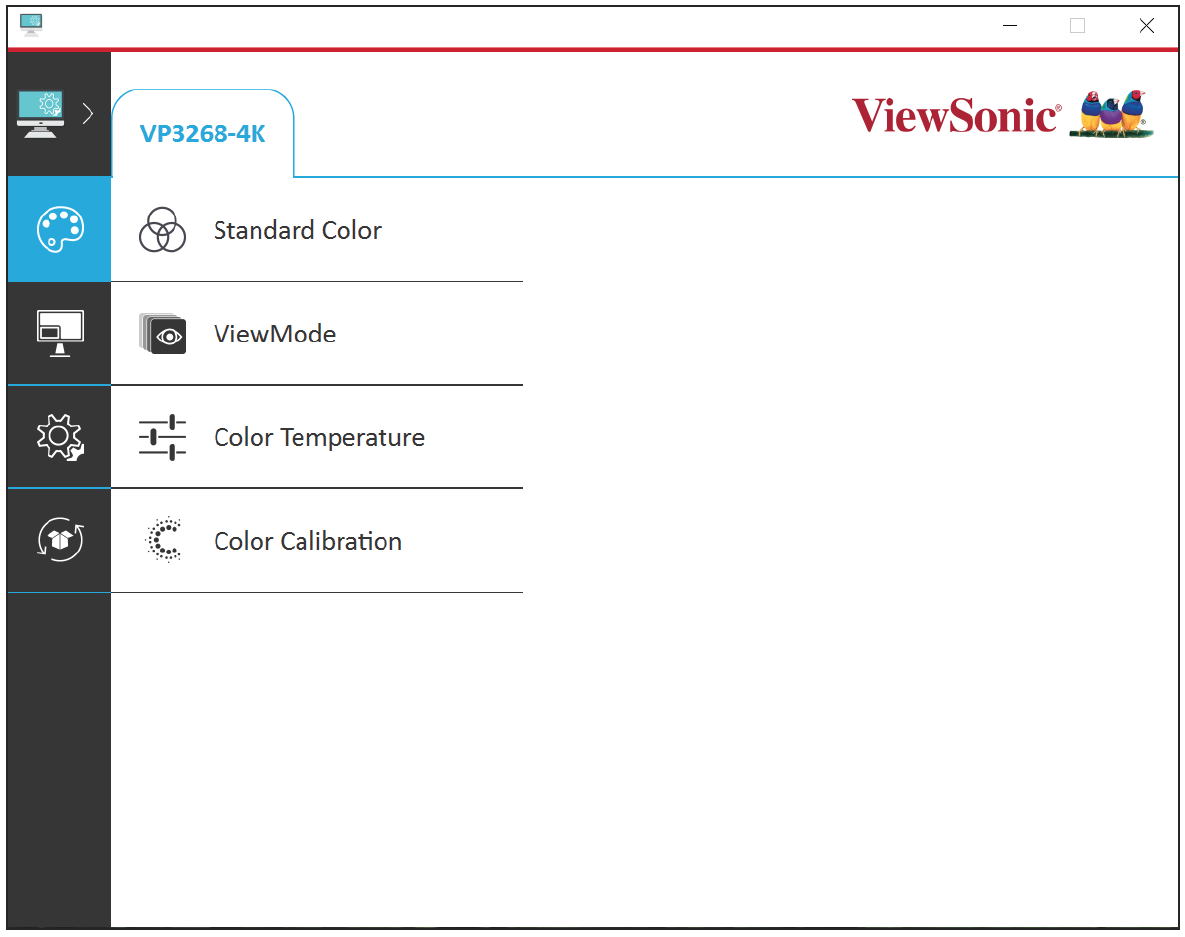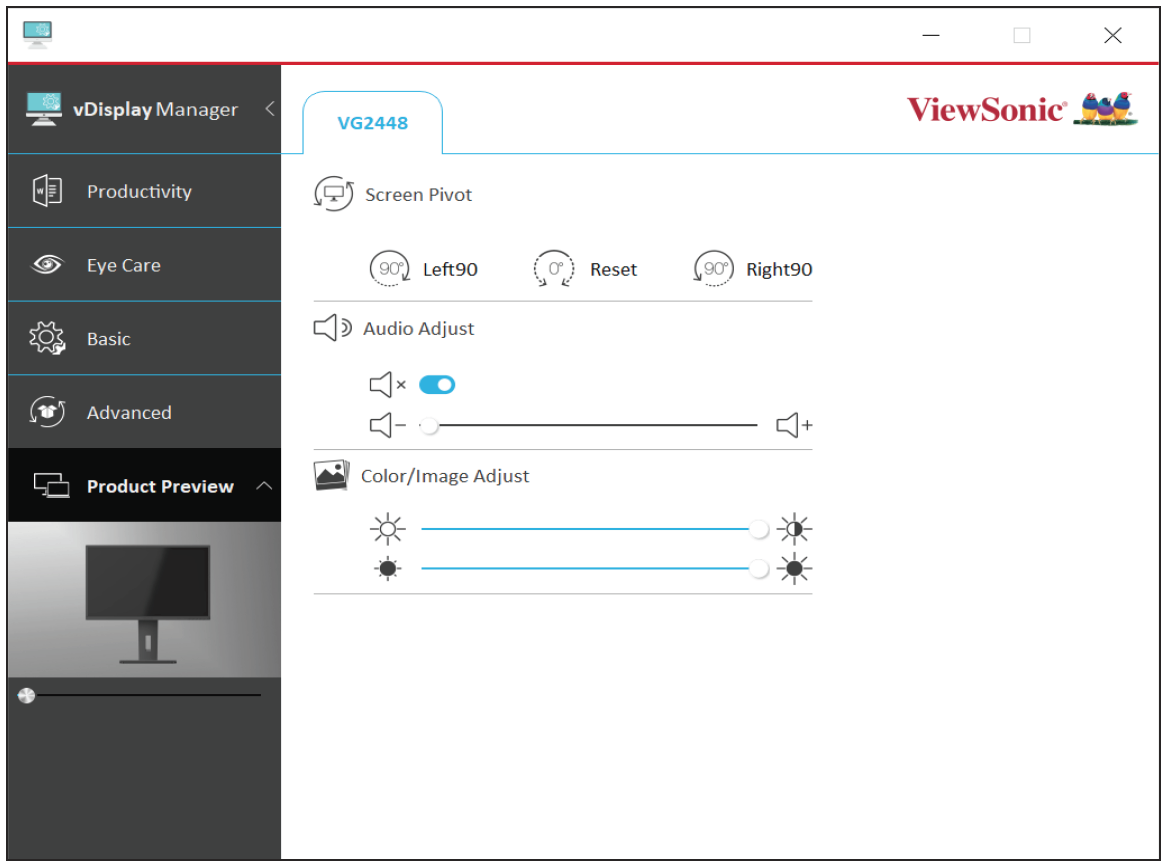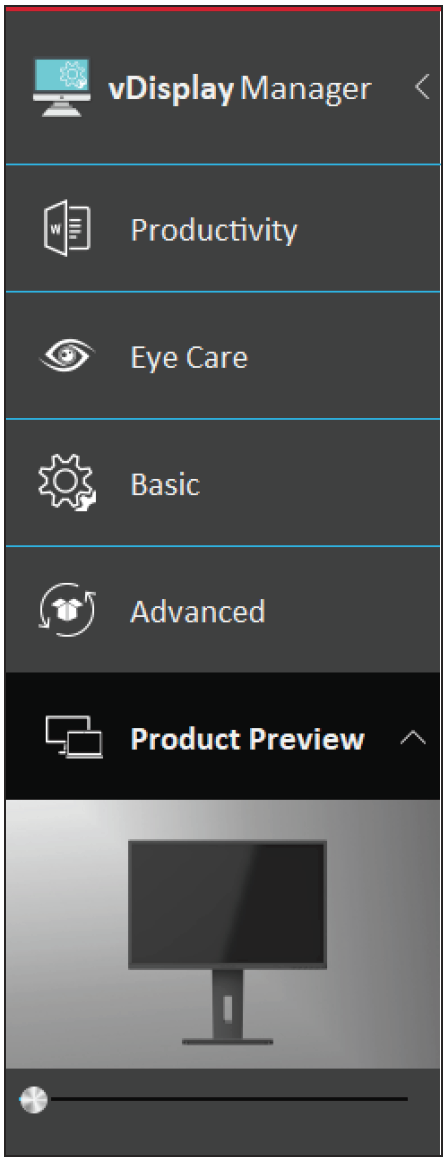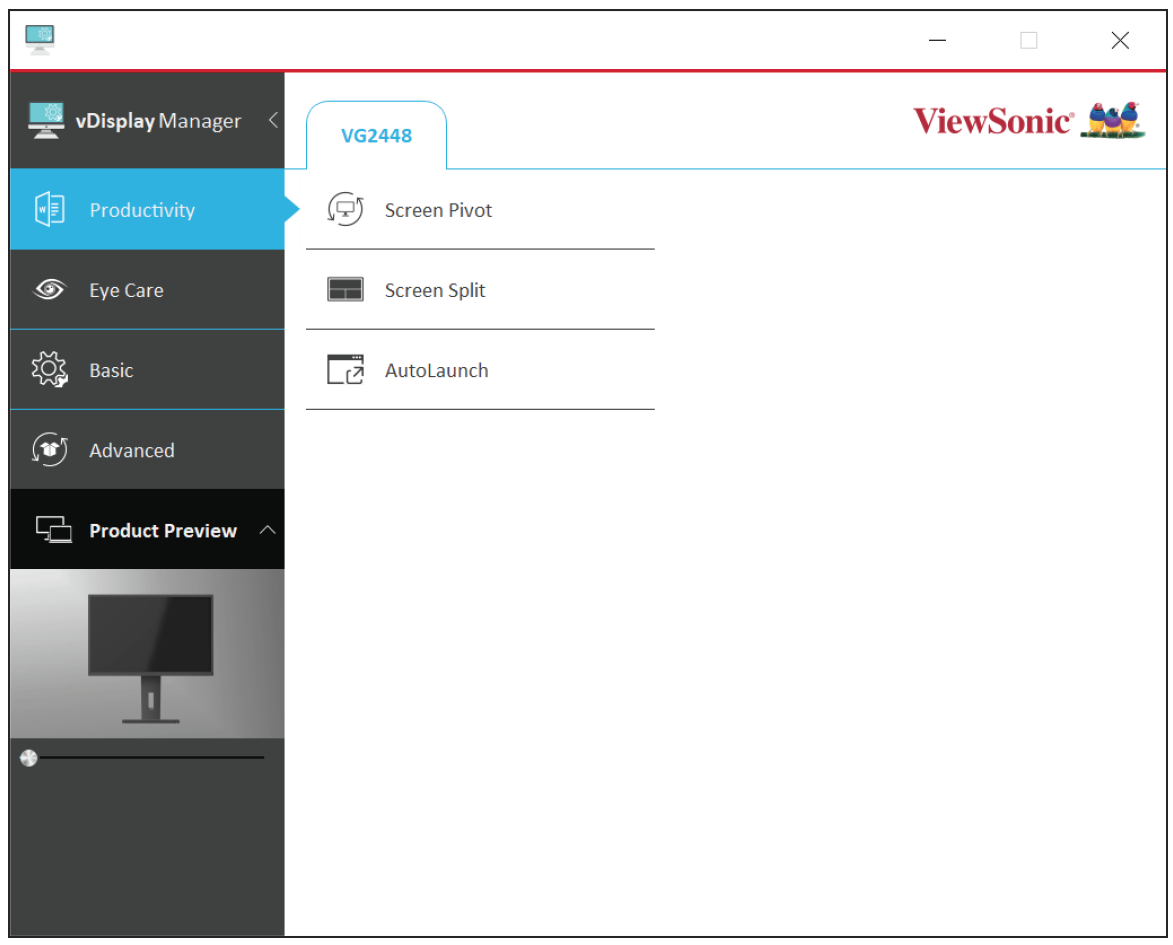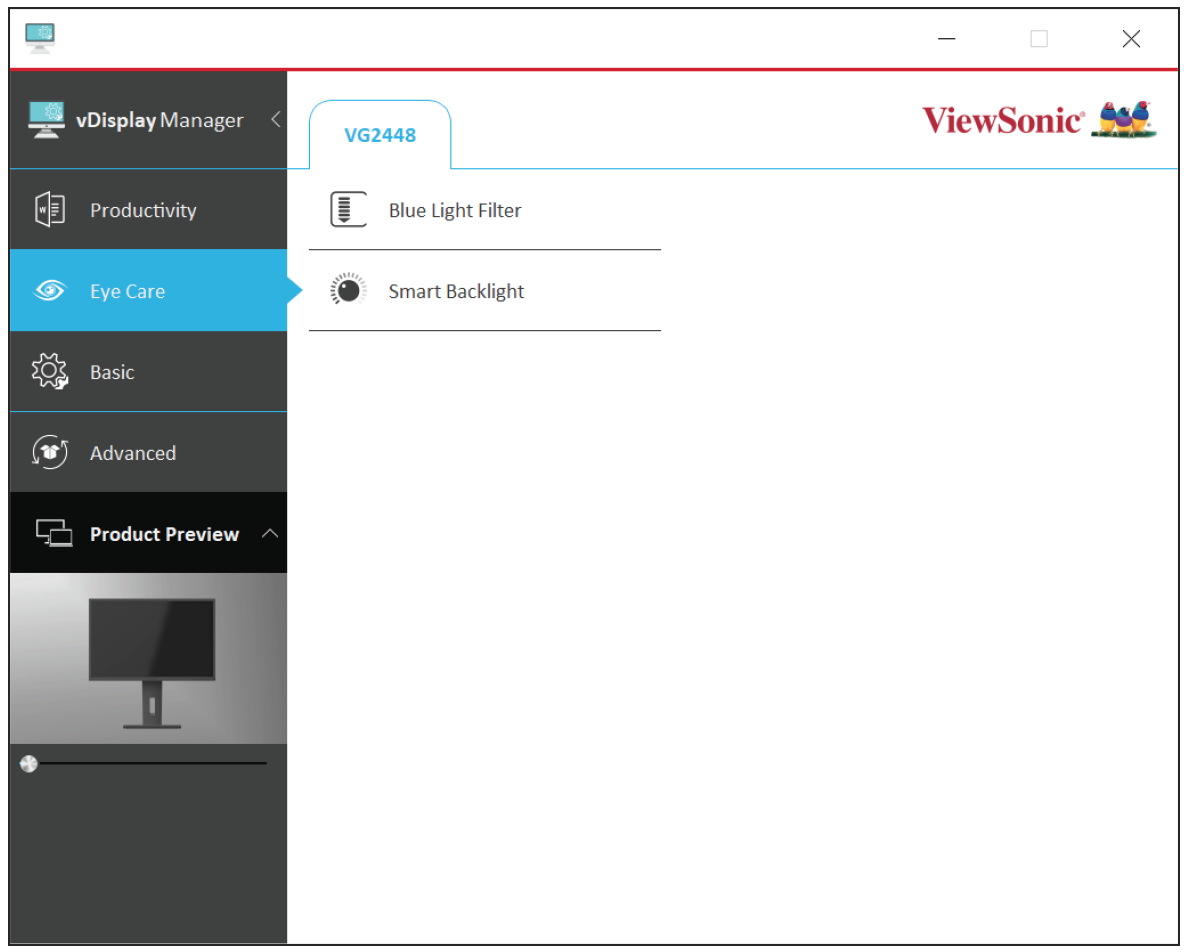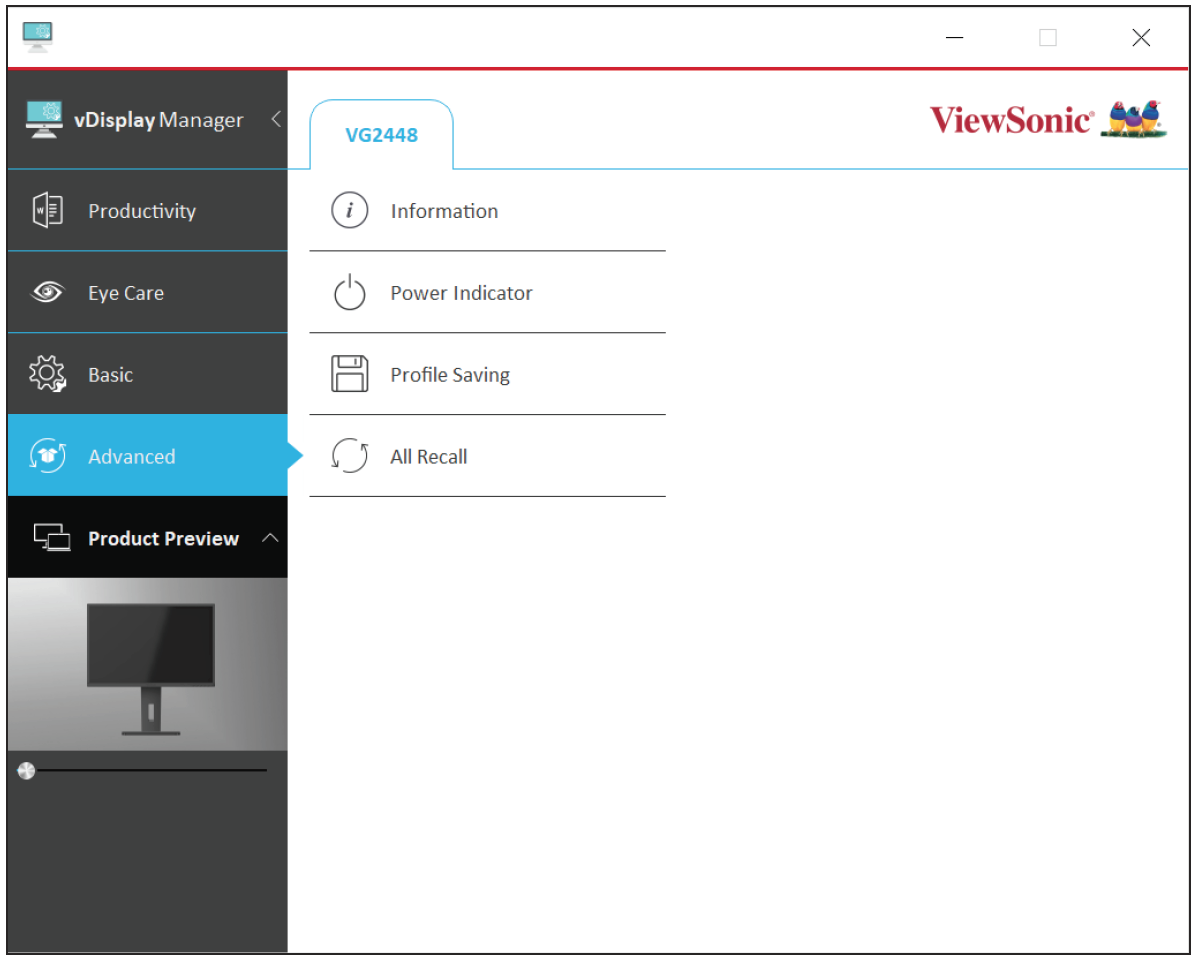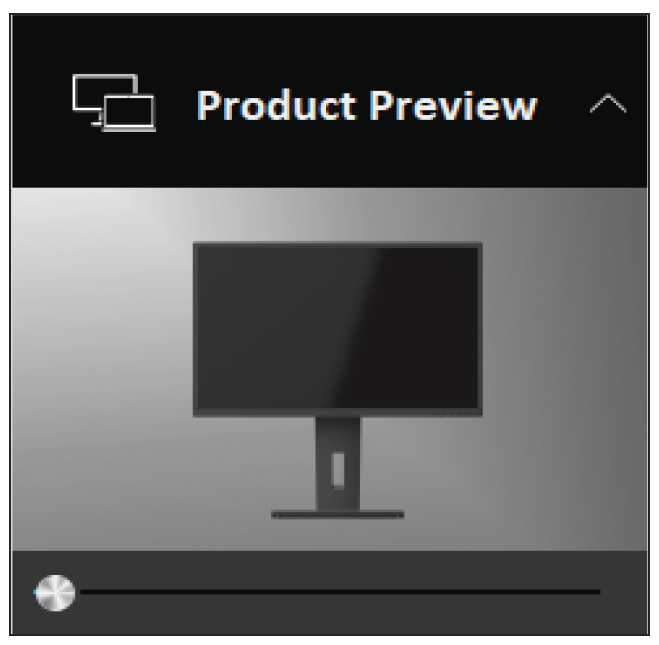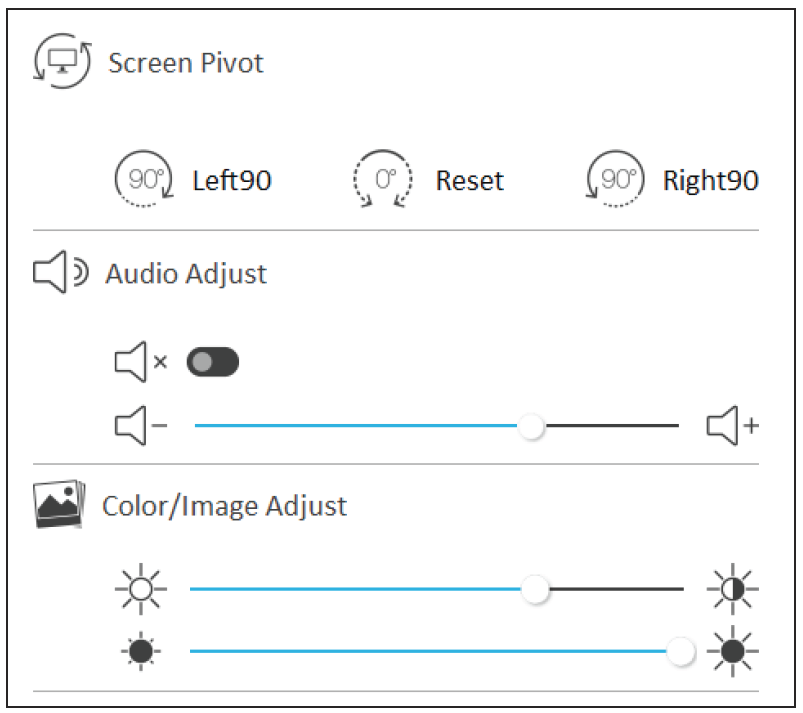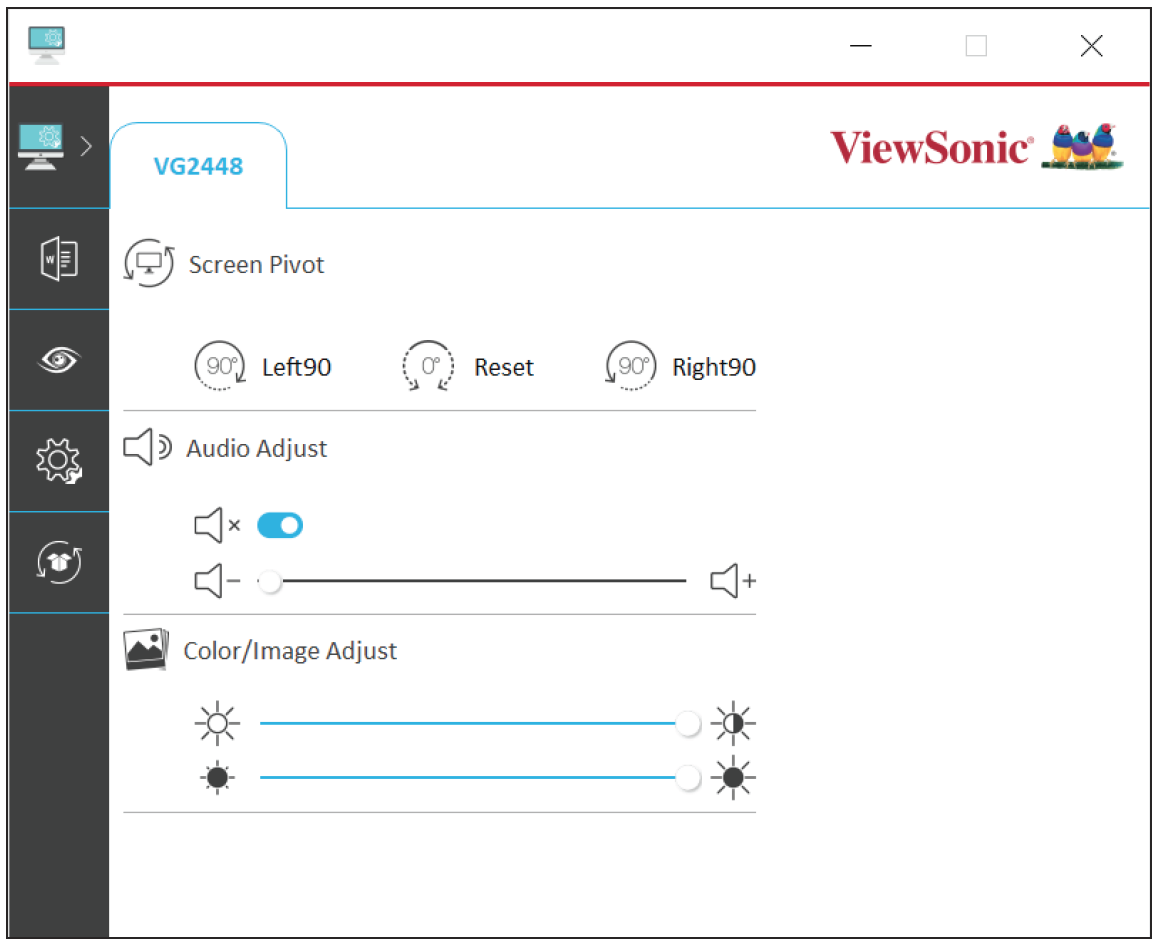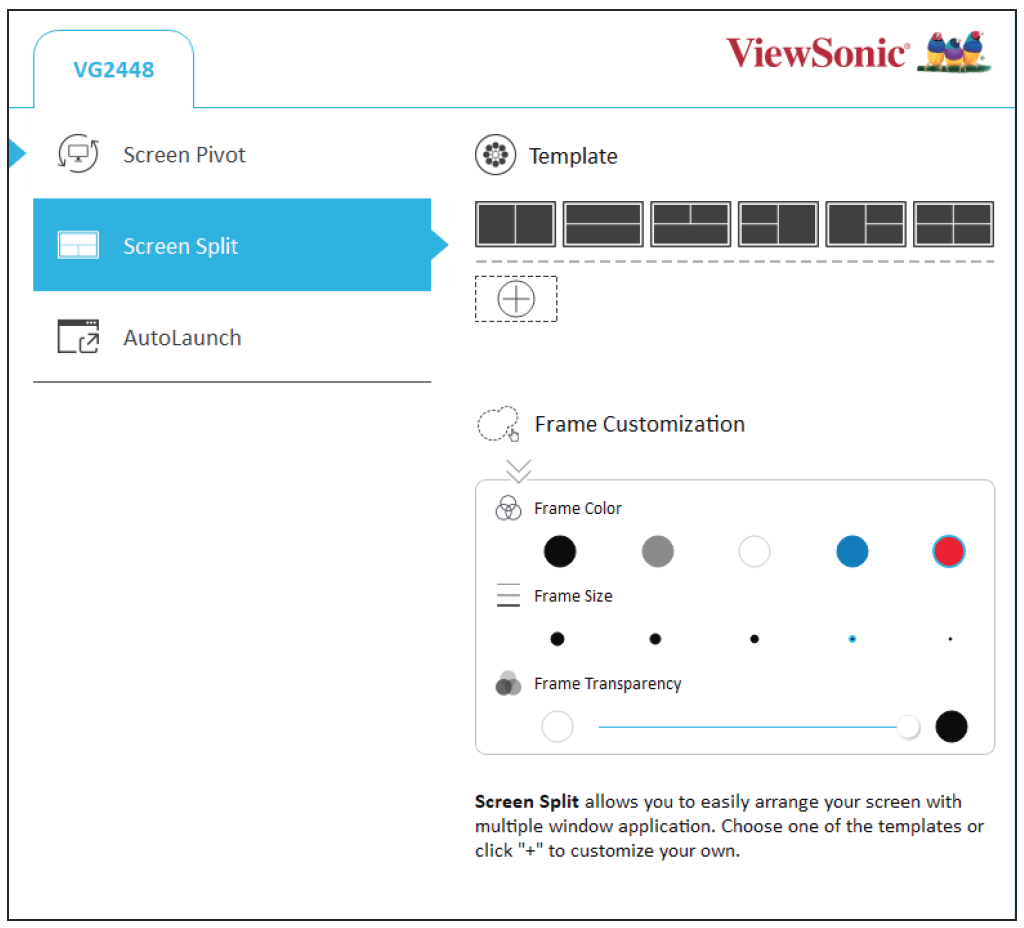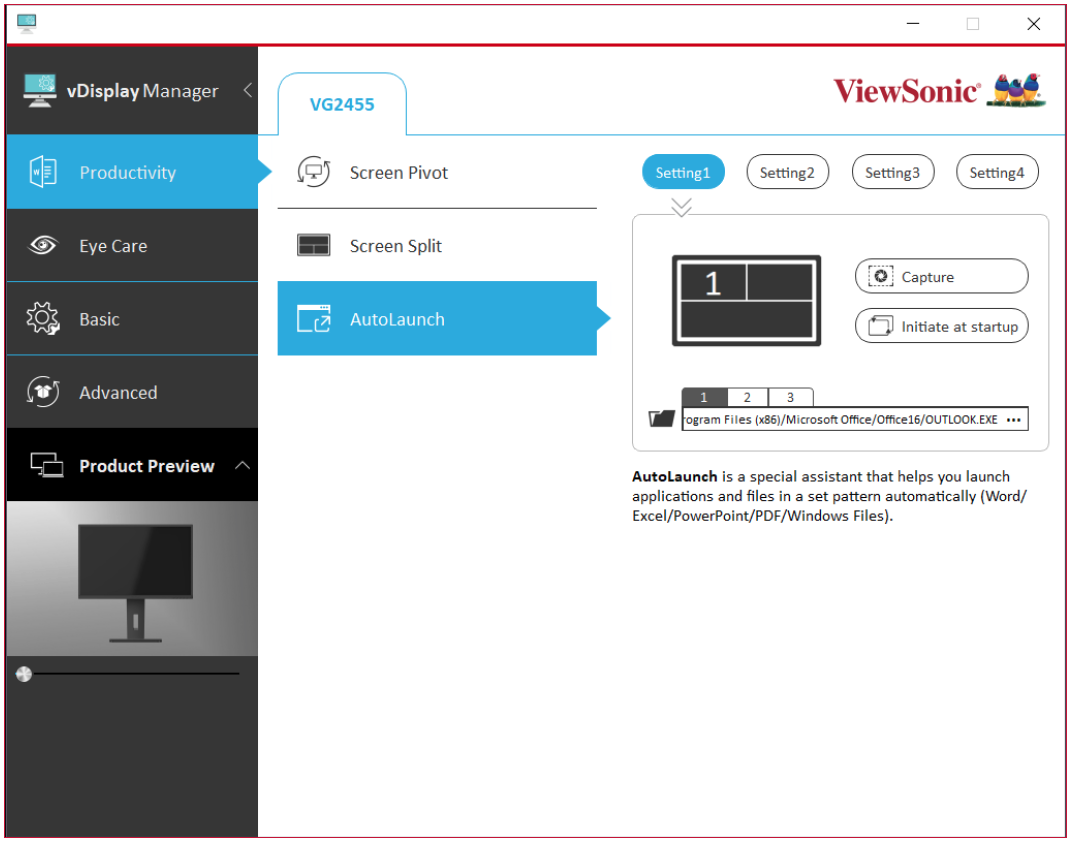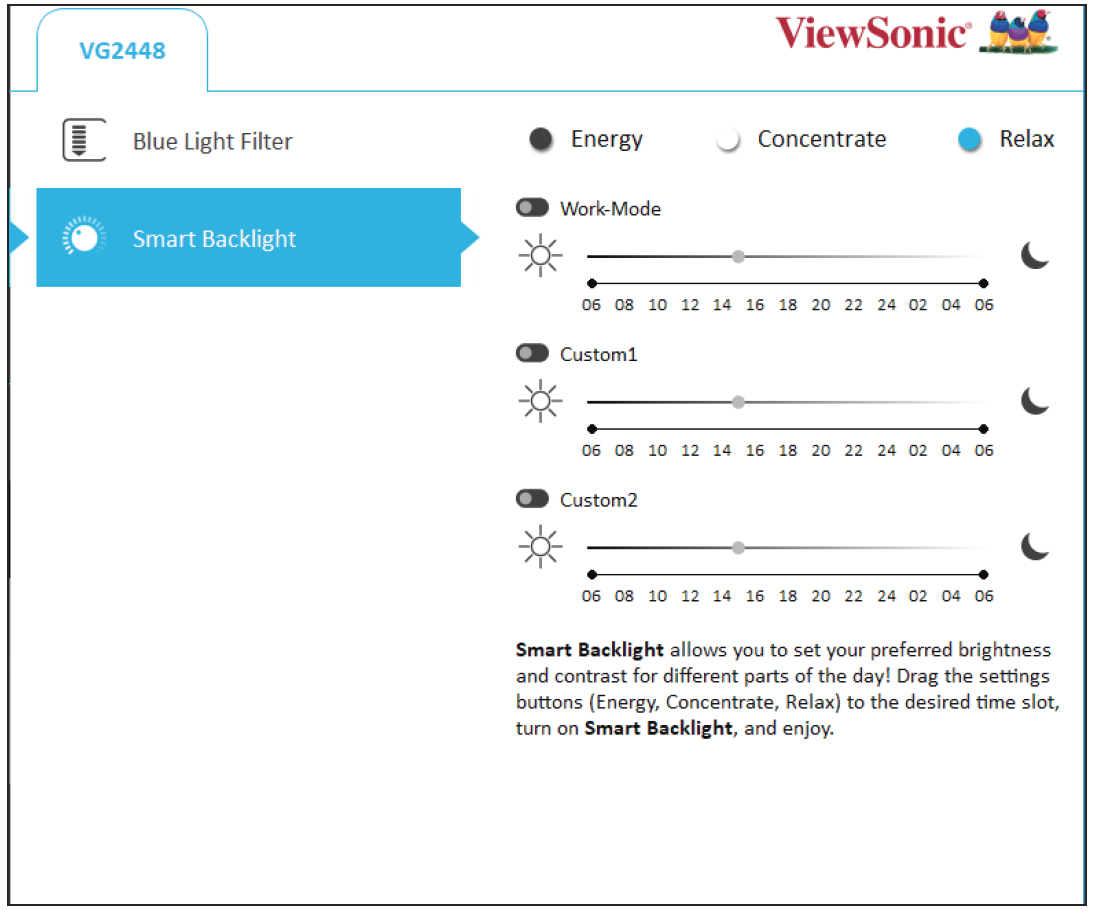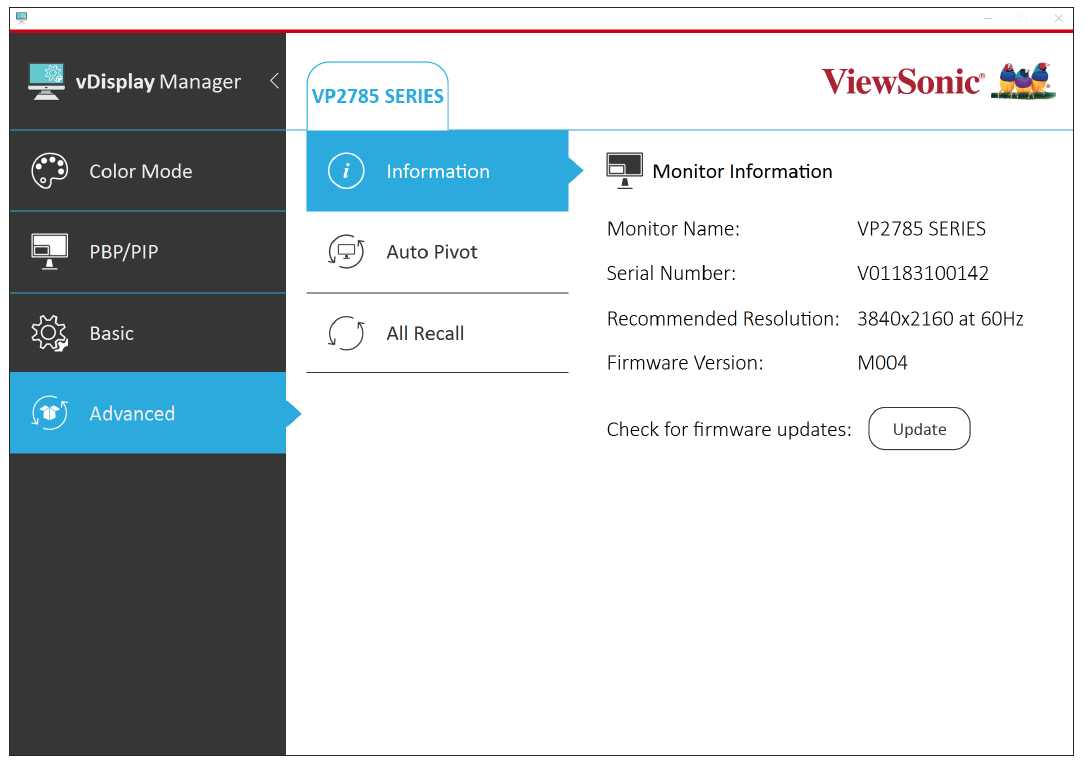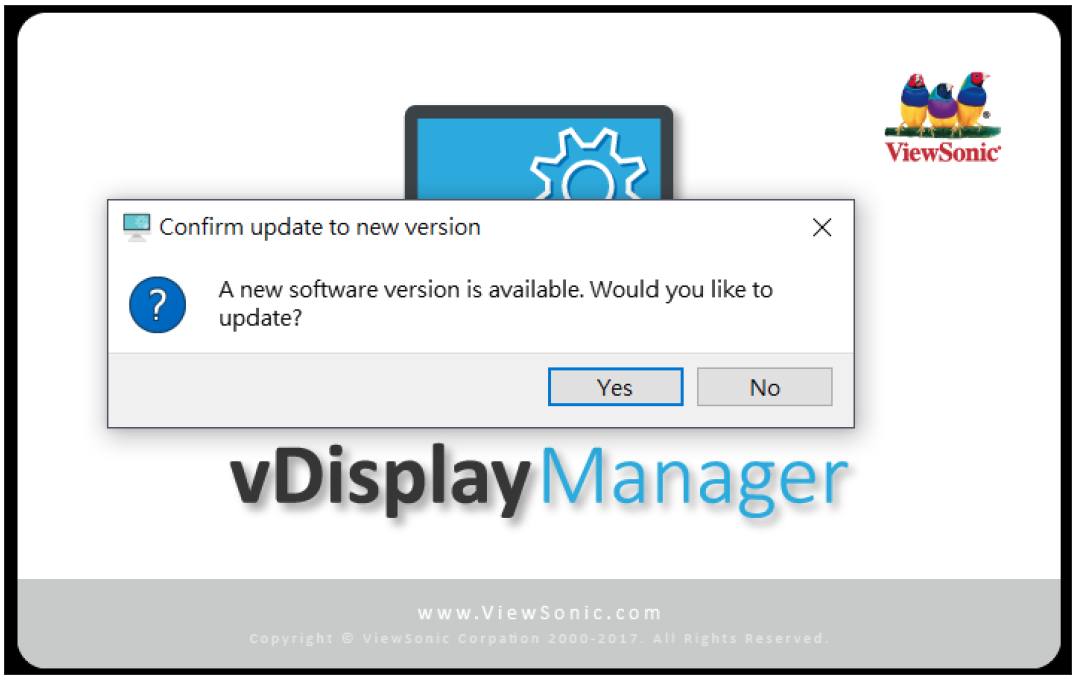vDisplayManager
What is vDisplay Manager?
vDisplay Manager improves your productivity and puts the On-Screen Display (OSD) Menu controls on your monitor’s screen. Here you can quickly and easily adjust the monitor’s display, increase user efficiency, and make your viewing experience more comfortable.
VP Series
- Quckly set Standard Color, ViewMode, Color Temperature, and Calibration options.
- Improve productivity with PBP/PIP.
- Adjust Brightness, Contrast, Image Sharpness, Blue Light Filter, Audio, and Input Source.
- Easily set Screen Pivot with Auto/CW/CCW/Reset.
Monitor Support
Currently, vDisplay Manager supports the VP Series of monitors. It specifically supports:
|
|
|
|
|
|
|
|
|
VG Series
- Adjust Screen Pivot, Audio, Brightness, and Contrast.
- Quickly access ViewMode options.
- Access the Blue Light Filter and Smart Backlight for comfortable viewing.
- Improve productivity with Screen Split and AutoLaunch.
Monitor Support
Currently, vDisplay Manager supports the VG Series of monitors. It specifically supports:
|
|
|
|
|
|
|
|
Where to get vDisplay Manager?
vDisplay Manager can be downloaded at: http://www.viewsonic.com/
After the download completes, launch the setup file and follow the on-screen directions to install the software.
Once the installation has finished, click on the vDisplay Manager icon to launch the software.
Connection Methods
In addition to downloading the software, ensure that your monitor(s) are properly connected via:
- USB Type-C
- HDMI and USB Upstream (USB Type-B), or
- DisplayPort and USB Upstream (USB Type-B).
- NOTE: If a VP/VG series monitor is not detected, the software will automatically close.
Menu Layout and Features - VP Series
Tags
At the top of each menu screen a Tag will be displayed, one for every monitor connected.
- NOTE: Up to four (4) monitors can be connected and tagged, however, this is dependent on your computer’s graphics card capability.
Sidebar Menu
On the left side are the sub-menus:
| Sub-menu | Options | |
|---|---|---|
| Color Mode |
| |
| PBP/PIP |
| |
| Basic Settings |
| |
| Advanced Settings |
|
More settings can be adjusted via the sub-menus: Color Mode, PBP/PIP, Basic Settings, and Advanced Settings.
Color Mode
| Menu Option | Description |
|---|---|
| Standard Color |
sRGB Adobe RGB EBU SMPTE-C REC 709 DICOM SIM DCI-P3 |
| ViewMode |
Standard Movie Game: FPS 1/Game: FPS 2 Game: RTS Game: MOBA Web Text MAC Designer: CAD/CAM Designer: Animation Designer: Video Edit Photographer: Retro Photographer: Photo Photographer: Landscape Photographer: Portrait Photographer: Monochrome |
| Color Temperature |
Panel Default Bluish Cool Native Warm User |
| Color Calibration |
Color Calibration: CAL 1 Color Calibration: CAL 2 Color Calibration: CAL 3 |
PBP/PIP (Picture-by-Picture/Picture-in-Picture)
| Menu Option | Description |
|---|---|
| PBP (Picture-by-Picture) |
Adjust layout preference, select input sources, set color modes, and turn on Smart Resolution to set your PBP screen with its ideal resolution at full screen. |
- NOTE: Please note how many screens can be supported:
| Screen Division | Model Support |
|---|---|
| 4 screens |
|
| 2 screens |
|
| Menu Option | Description |
|---|---|
| PIP (Picture-in-Picture) |
Adjust layout and size preference, select input sources, set color modes, and adjust the PIP screen size with the sliding bar. |
Basic Settings
| Menu Option | Description |
|---|---|
| Color Adjust | Adjust Brightness and Contrast. |
| Image Adjust | Adjust Sharpness and Blue Light Filter. |
| Audio Adjust | Increase, decrease, or mute the volume. |
| Input Select | Toggles between the various input options that are available for the monitor. “Auto Detect” can also be toggled On/Off. |
Advanced Settings
| Menu Option | Description |
|---|---|
| Information | Displays the Resolution, Timing mode, Model Name, Serial Number, Firmware Version, and an option to check for Firmware updates. |
| Auto Pivot | Toggle On/Off and rotate the screen. |
| All Recall | Resets all the settings to default. |
ViewSonic® Homepage Link
In the top-right corner, a link to the ViewSonic® home page is placed for convenience.
In addition to the standard view of the Main Menu, the Sidebar Menu can also be minimized by selecting the tab as shown below:
Menu Layout and Features - VG Series
Tags
At the top of each menu screen a Tag will be displayed, one for every monitor connected.
- NOTE: Up to four (4) monitors can be connected and tagged, however, this is dependent on your computer’s graphics card capability.
Sidebar Menu
On the left side are the sub-menus:
| Sub-menu | Options | |
|---|---|---|
| Productivity |
| |
| Eye Care |
| |
| Basic Settings |
| |
| Advanced Settings |
|
More settings can be adjusted via the sub-menus: Productivity, Eye Care, Basic Settings, and Advanced Settings.
Productivity Menu
| Menu Option | Description |
|---|---|
| Screen Pivot | Pivot the screen -90°, +90°, or 0°. |
| Screen Split | Divide the screen into several windows for better productivity. |
| AutoLaunch | Automatically launch several windows in a set pattern with certain applications already open. |
Eye Care Menu
| Menu Option | Description |
|---|---|
| Blue Light Filter | Adjusts the filter that blocks high-energy blue light for a more comfortable viewing experience. |
| Smart Backlight | Set your preferred brightness and contrast for different parts of the day. |
Basic Settings
| Menu Option | Description |
|---|---|
| Color/Image Adjust | Adjust Contrast, Brightness, and/or Sharpness. |
| ViewMode | Select one of the many preset viewing settings. |
| Audio Adjust | Increase, decrease, or mute the volume. |
| Input Select | Toggles between the various input options that are available for the monitor. “Auto Detect” can also be toggled On/Off. |
Advanced Settings
| Menu Option | Description |
|---|---|
| Information | Displays the Resolution, Timing mode, Model Name, Serial Number, Firmware Version, and an option to check for Firmware updates. |
| Power Indicator | Toggle the Power Indicator Light On/Off. |
| Profile Saving | Save preferred settings. |
| All Recall | Resets all the settings to default. |
Product Preview A 360° degree view of the selected monitor will be shown here. This sub-menu can be minimized as well.
Adjustable Settings
The Main Menu has several common settings that can be quickly adjusted.
| Menu Option | Description |
|---|---|
| Screen Pivot | Pivot the screen -90°, +90°, or 0°. |
| Audio Adjust | Increase, decrease, or mute the volume. |
| Color/Image Adjust | Adjust the brightness and/or contrast. |
ViewSonic® Homepage Link
In the top-right corner, a link to the ViewSonic® home page is placed for convenience.
In addition to the standard view of the Main Menu, the Sidebar Menu can also be minimized by selecting the tab as shown below:
Screen Split
Allows the user to divide the screen into several windows. Some default templates are provided, however, customized templates can also be created and saved.
Additionally the frames of the templates can be customized by adjusting the Frame Color, Frame Size, and Frame Transparency. To create a custom template:
- Click the “+”.
- Then draw your custom frames on-screen.
- NOTE: Only vertical and horizontal lines can be drawn.
- At anytime you can Save, Delete, Undo, or Redo with the icons at the top of the screen:
- NOTE: You can Edit or Delete any custom template by right clicking on it in the template selection area.
AutoLaunch
The user can capture and automatically launch several windows in a set pattern with certain applications already open within them.
- NOTE
- AutoLaunch supports capturing Office 2010/2013/2016 (Word/Excel/PowerPoint), PDF, and Windows Files.
- If the file is not supported for direct capturing, the user can designate the file via “...”.
- After using “Screen Split” to divide the screen, drag and drop your preferred applications into each frame.
- Choose the preferred “Setting” (Setting 1/2/3/4).
- Click “Capture” to save your screen setup. You can click “Initiate at Startup” to have your preferred screen setup load at startup.
- NOTE: You can adjust which program opens in which window by clicking the “1, 2, ..” and “....”.
Smart Backlight
This feature allows the user to set preferred brightness and contrast for different times of the day.
- Drag and drop the preferred settings button: Energy, Concentrate, and/or Relax, to the desired time slot.
- NOTE: You can also right click on the time line to add the settings.
- To adjust the settings button, left click on the word. Then you will be able to adjust the brightness and contrast.
- Once your preferred settings are finalized, turn on Smart Backlight by left clicking the toggle switch.
Firmware Update
For the best display performance and to resolve any known issues, it is best to keep your monitor updated with the latest firmware version. With the USB cable and firmware update tool, you can easily update your monitor firmware any time.
To update the firmware, do the following:
- Click on the Advanced sub-menu, then Information.
- Connect the USB Type-B male cable (square with 2 cut corners) to the USB Type-B port of your monitor. Then connect the other end of the cable to the USB port of your computer.
- Click Update to upgrade your monitor’s firmware, and wait until the upgrade process completes.
Software Update
If a new software version is available, a pop-up message will appear at the launch of vDisplay Manager as shown below:
After selecting Yes and successfully updating the software, the below message will appear:
- NOTE: It is suggested that the user always updates to the latest software version available.

